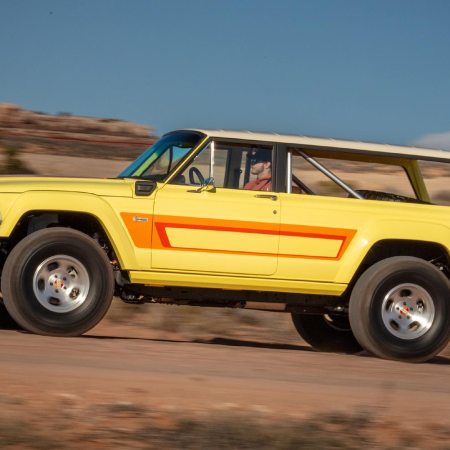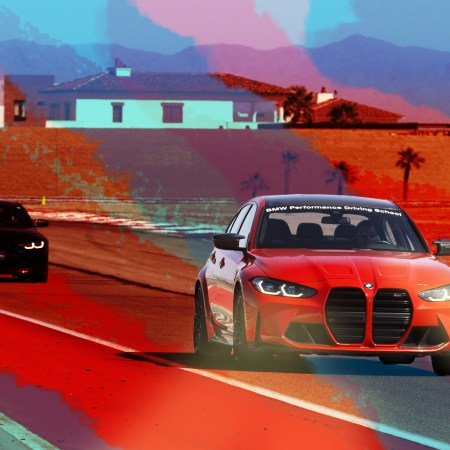In the mid ‘60s, Carroll Shelby and a small group of Southern California hot-rodders built a car that beat Ferrari at Le Mans.
“It’s a pretty amazing story,” says Doug Campbell. “The Daytona Coupe, they built that in 90 days, from a napkin sketch to a car running 188 miles an hour at Riverside in testing.”
Campbell works at Hillbank Motorsports, where they recreate — with painstaking precision — five of the most coveted race cars of the 1960s. Each year they make about 450-500 models; their first was the Cobra, which Shelby licensed to them.
“We also make the fiberglass continuations for Shelby,” Campbell explains. “Chassis, suspension, body, everything … All in, you get the total 1960s experience with those cars. They’re in the Shelby registry, they have Shelby chassis numbers — the whole deal.”
We recently drove down to Irvine for a tour of Campbell’s workshop, and he told us the stories behind each of the pearly rides they have on offer.
The AC Ace 289 Slabside Cobra
“This is the 289 slabside. This car is the original body and chassis that Carroll Shelby found over in England, which was known as the AC Ace. AC cars over in England had a body and chassis, but no engine. Carroll initially approached Chevrolet and was turned down: they didn’t want to create a sports car because they already had the Corvette. Then he approached Ford, at that time being run by Lee Iacocca. And the famous line from that meeting — because Carroll Shelby was a pretty aggressive guy — was after a few minutes, Iacocca said, ‘Give that guy a couple of engines and get him out of here before he bites somebody.’”
The Superformance
“The cool thing is our Cobra replicas ride really nice. Our Mark 3 replica has a square tube chassis with arms, coil overs on all four corners, and gas shocks that are custom-tuned to our car. And this car with the 18-inch wheels and tires on it will embarrass BMW M3s all around the track all day long. It is an incredibly nice-driving, well-handling car.”
The GT-40 Models 1 and 2
“You can actually take parts off of our car and use them to restore an original GT-40. You can actually buy one of our cars new and license it for vintage racing through SVRA or some of the other organizations for vintage racing because it is so true to the original car. And these cars are in the historical GT-40 registry. They’re eligible for the Shelby historical registry, and they also get original GT-40 Chassis numbers. So we’re just continuing on with new sequence numbers.”
The GT Daytona Coupe
“Carroll wanted to go over to Europe and beat Ferrari. He had a real vendetta against Enzo Ferrari. The problem with Cobras is they were aerodynamically limited. Once you got to about 150, max 160 miles per hour, the cars wouldn’t start to lift, and they were just a brick. Carroll Shelby’s second employee, Peter Brock, actually attended the LA Art Institute for car design … but he never told Carroll that. Carroll hired him to run the driving school out of Riverside, and Pete came on board because he wanted to be a driver for Shelby — he loved to drive.
But Brock’s first job after he left the institute was with General Motors in 1958, and he ended up designing the ‘58 Stingray racer, which became the ‘63 Stingray. So once he left and went to Shelby, he said, ‘I think I can come up with a design for the Cobra to beat the Ferraris over in Europe.’ The Ferraris were running 180 miles per hour then.
So Shelby gave Brock a Cobra chassis and 90 days to come up with something to beat Ferrari, and that’s when Peter came up with the Daytona Coupe. The body on this Coupe features a very unique rear end. Peter had studied a 1920s German bus designer whose last name was Kamm. He saw on the buses that if you really chopped the tail off, it would break the airflow off of the back and actually create a vacuum behind the bus that would push the bus forward and make it a lot more aerodynamic.
Peter applied that Kamm tail to the Coupe, and lo and behold, 90 days after he penciled the first napkin sketch, their first test ran 188 miles per hour. Ken Miles (the test driver for Shelby) couldn’t believe it. He actually made them check the gear ratio so they could match the RPMs he was running, because they didn’t have speedometers. So they matched the RPMs and the gearing in the car, and realized that they had in fact gone 188 miles per hour, and that was with one of their cheap mechanics, Granddaddy Collins, on the passenger side with no seat, his knees wedged up under the roll bar.
In ‘64 they would have won the world title, but Ferrari had the last race at Monza canceled because he had a lot of political influence. He knew that more Daytonas were built and competing, and he knew they [Ferrari] were going to get beat for the world title, and he had it canceled.
So the next year they came back and the Shelbys won the world title, and this car is still the only American car ever to beat Ferrari for a world GT title. They only built six of the originals. The last one sold at auction in Monterey in 2012 for 7.25 million and set a record for an American car at auction at the time.
I’ve had one of these [i.e., one of Hillside’s reproductions] for 12 years and have a little over 50,000 miles on it now. I’ve only it had up to about 168. It feels like it wants to go faster, you just need more room. The car is so well mannered, and so well planted.
Since we’re licensed by Shelby, we had Peter Brock come back and do our car. If you look at our car, it has no two lines in common with the original. This was Peter’s chance to redo the Daytona with a clean sheet of paper and not be limited to a Cobra chassis and 90 days. The only way Peter would do this project is if we brought Bob Netstat on board, who was Shelby’s chassis designer from the ‘60s.
So this was really a chance for the original team to come back and redo the Daytona Coupe, kind of a version 2.0, from a clean sheet of paper. But it has the original DNA. The two original designers of the car redesigned the car for us into what is a true GT car. It can do anything. I can take it on a five-day trip with my wife and it has a ton of room in the back for luggage. I can turn around and go do a track weekend and go out and embarrass some Corvettes out on the track. So it is truly a real grand touring car.”
The Corvette Grand Sport
“The Corvette Grand Sport is similar to the Daytona, and it raced at about the same time. It was designed to kill the Cobras, because the Cobras came on and started killing the Corvettes. So [Zora Arkus] Duntov, who worked with GM at the time on the Corvette program, decided he was going to come up with a Cobra Killer — the Corvette Grand Sport. There are only five of the original Grand Sports left, and eventually GM canceled the program. Duntov was able to save the cars — they were originally supposed to be scrapped. All the cars we do — the Daytona Coupes, the Cobras, the Corvette Grand Sports, the GT40s — all have real pin-drive wheels. There’s no fake spinners with lug nuts: everything’s done to original spec.”
This article was featured in the InsideHook LA newsletter. Sign up now for more from the Southland.





















